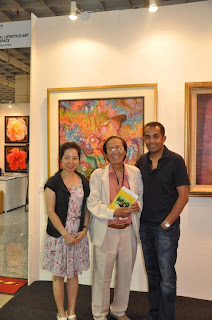A Solo Art Exhibition
 |
| Rira, 2001 99cm x 100cm. Oil |
Born on September 26, 1938 near Solo (Central Java), Jeihan Sukmantoro has been an Indonesian painter of repute for several decades. Javanese-Hindu traditions had the most significant influence on Jeihan as a child and are said to be the source of his esthetic stimulus later in life.
“I used to dream about becoming a dalang”, he once said, referring to the puppet master in a wayang kulit, a shadow play, which has a big role in Javanese culture. Wayang kulit is said to embody the philosophy of Javanese culture and is the gateway to understanding Javanese literature, music and classical theatre. Jeihan not only paints, but writes poetry and has been active in literature and involved in Indonesian theatre.
An accident at age 6 left Jeihan with brain damage and epilepsy. For the next eight years he did not go to school. He spent the time doing only one thing: drawing. Figures and landscapes kept him preoccupied until he returned to school.
Astonishingly, his intelligence had greatly improved, because he successfully completed junior high school and was accepted into a senior high school that focused on art. He received a class promotion after he held a solo exhibition of 30 watercolours.
 |
| Tarijawa, 2011 180cm x 140cm. |
When he later enrolled in the School of Fine Art and Design of the Bandung Institute of Technology, he was already of the mindset that he would be a professional artist. This sowed the seeds of his rebelliousness. The school was set up to produce teachers of art, not professional painters and the rules and regulations were not supportive of students wishing to embark on a professional career. For instance, students were prohibited from holding exhibitions outside campus. Jeihan often broke the rule, justifying it on the grounds that they were opportunities to gain him wider experience and knowledge.
But it was more than just that. Jeihan wanted freedom. He wanted to be free and independent in developing his character. He wanted to visit the future. This seems to have been the drive for his trailblazing work. His works in the early days of his study were judged to have deviated from the educational rules, and he was ridiculed, criticised and even accused of blasphemy.
His works had figurative themes, incongruous with his school’s adoption of Cubism and abstract styles, though his works do seem to lie in the abstract field. He quit art school in his last semester. “I quit from the School of Fine Art and Design because I was bored!” he declared. That was in the mid-60s.
One early controversial work was an installation piece at an exhibition in the Balai Budaya Building in Jakarta in 1968. What did he do? He cut his Torso art piece into three. In the uproar, an art critic called Jeihan’s artworks rape. Jeihan’s ideas were too dynamic and way ahead of his time.
But it was a different story by the 1980s. In the decade before, art movements had molded thinking into accepting “wilder ideas”. Jeihan’s wild ideas gained traction. His maturing style made them easier to comprehend.
Jeihan’s status as a professional artist and his success in breaking into the market were confirmed by the billing he received on a poster advertising a joint exhibition with a senior artist in1985, which was organised by the Board of Art of Jakarta. The headline read: “The encounter of 2 eminent expressionists.”
 |
| Puspadewi, 2010 140cm x 140cm. |
Demand for his art soared, sparking a boom in demand for Indonesian paintings. The years following were particularly good for the Indonesian overseas fine art market.
One trait of Jeihan’s is blank eyes. He deliberately loses the eyes with flat black paint. The effect can be unsettling. What peculiarity of Jeihan’s is this? Perhaps just his way of saying, “I am not a follower of fashion.”
He seems to prefer women as his subjects, seeing a uniqueness in them. He sees them as mysterious and full of character. “Harmony is mysterious,” he says. He frequently paints the human figure in a space devoid of things, drawing attention to the physical and non-physical reality of things.
The flatness in some of his paintings is reminiscent of a wayang kulit, and similarly the way in which the subject matter is positioned in side profile away from the painter is like the angle the dalang holds his puppets. It is done with an intellectual awareness.
From 1997 onwards, Jeihan has appeared to move towards a certain spiritual tranquility, reflected in a more minimalistic style of painting. His subjects are more relaxed and more playful, but their figures show distortion and less being.

































































